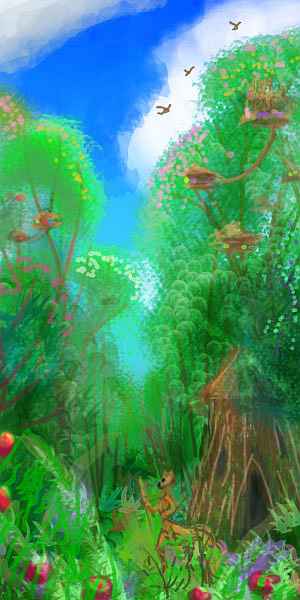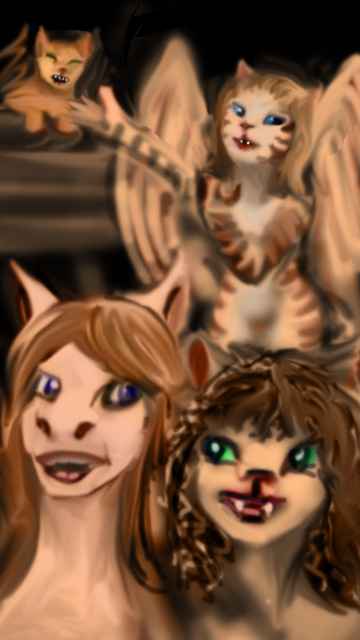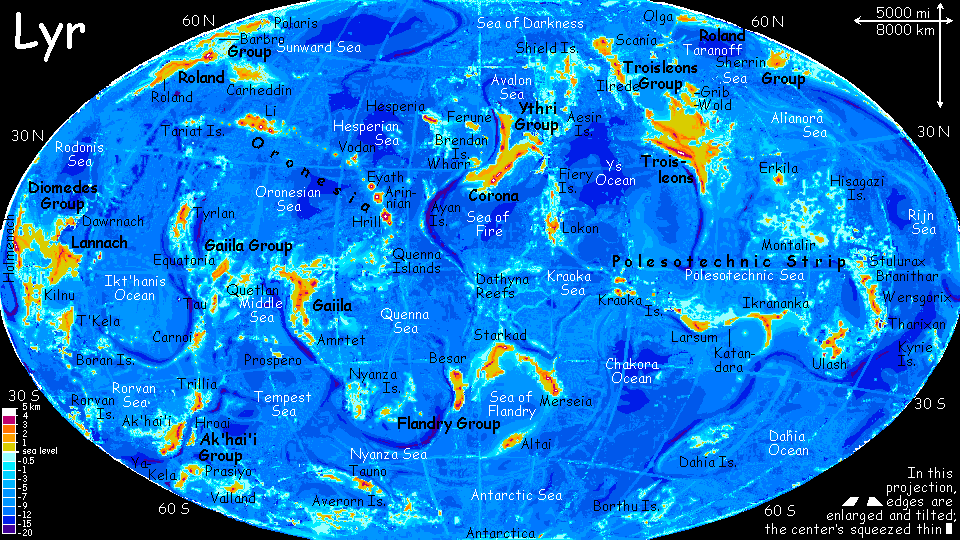World Dream Bank
home -
add a dream -
newest -
art gallery -
sampler -
dreams by
title,
subject,
author,
date,
places,
names
CULTURE OF LYR
by Chris Wayan, 2006
Lyr (home) - map - creatures - cultures - evolution - climate - geology - gazetteer - nomenclature - definitions - building Lyr - more worlds? Planetocopia!
For the culture of particular Lyran species, from architecture to sex customs, see creatures. How did Lyr's environment shape these people? See evolution. And the regional tours bristle with passages on Lyran oddities:
But the rest of this page is something broader: my attempt to wrestle with Lyran culture (and that means multispecies culture) as a whole.
THE CULTURAL EFFECTS OF MULTISPECISM
Well... let's start with the opposite--the effects of a unispecies society like ours. In agriculture or forestry, monoculture is a risky strategy with heavy costs to the land. Why assume the human monoculture is any different? Some truisms about our culture:
- we clear forests
- we spread (pushed by population pressure) into regions ill-suited for us and alter the land instead of ourselves, creating unstable and impoverished ecologies
- we congregate into groups--and large groups offer better economic and mate-selection opportunities. In early days, city life had risks to match their allure: more disease. Now that cities are as healthy as rural areas, billions flee the farm...
- we split into diverse societies, which may compete--or fight
We take such quirks, and dozens more, for granted--the nature of civilization. But at least three factors shape our particular civilization, and only one will be universal:
- 1: INTELLIGENCE
- Does intelligence have a character, divorced from species? We won't know what traits are universal to all thinking creatures until we find (or acknowledge, here on Earth) other intelligent species. But there's evidence for a character: other intelligent species on Earth recognize curiosity, flexibility and innovation, empathy and communication, awareness of a past and future, as valuable, as akin to their own gifts, even across wide species-gaps. Consider how wild ravens and wolves will trust human researchers who've proven themselves harmless; or how ravens will cooperate with wolf packs, leading them to caribou. Or dolphins' treatment of humans as peers. Or the recent human attitude-changes toward whales, elephants and wolves--even a species as self-centered as our own immediately feels a certain kinship with any creature showing intelligence. I'm arguing that may not be a human trait but an intelligent one, common to (at the least) wolves, ravens, humans and cetaceans.
This isn't mere rhetoric, but a theory allowing predictions. For example, the treatment of parrots and ravens should improve sharply as recent research on their high intelligence is more broadly known.
- 2: HUMANITY
- That is, our species-character, from the general (four-limbed vertebrate, omnivores, mammals) down to quirks we take for granted (near-baldness, fear of heights, love of swimming yet hating rain). Some of these traits aren't obvious consequences of EITHER intelligence OR our primate lineage. Until this decade, many anthropologists called such quirks side effects of our rise to intelligence, but really--a love of swimming? Hey, fish is brain food! Bare skin? Well, sparks set all the furry prehumans on fire! (Beards are evidently made of asbestos...)
I'm oversimplifying unfairly, but such arguments do feel thin and contrived. I think these traits arise from our specific history, not always related to our evolving intelligence; and I predict that other intelligent species around the universe will have quite different species-traits.
- 3: MONOSPECISM
- Our civilization involves exactly one intelligent species. As Jared Diamond has pointed out, civilization advances faster where there's a rich pool of domesticable species, both plant and animal--for food, fiber, labor, communication and transport. But on Earth, we can't communicate with the other species we suspect are intelligent (elephants, dolphins and whales). None but elephants (as slave labor) ever contributed to our civilization and none at all benefit from it--quite the opposite. Even the next tier of intelligent animals--apes, wolves, ravens and parrots--are peripheral to our great leap forward.
Maybe our local patch of ground has a shortage of suitable candidates (Diamond's argument about crop-species, extended to planetary scale), or maybe it's our rotten personalities. Can't tell from a sample of one! But notice, we never tried to breed dogs smarter than their wolf ancestors, or breed a class of ape servants, or breed huge parrots who fully understood human speech, as messengers and heralds--let alone treat any of these as friends or equals, as citizens in a multispecies civilization. In the clearest case, rather than try to develop a pidgin language with elephants, we captured slave laborers and taught them a handful of commands.
I fear what evidence we have suggests we're just control freaks... but whatever our reasons, we're going it alone. What characteristics of our civilization are the result of that solitude? We won't know until we meet true multispecies cultures.
Aside from thought-experiments, all we can do is compare multiracial, multicultural human societies having many domesticated animals, to isolated tribes with few domesticable animals--and that's a weak analogy. But a suggestive one. The more a human tribe goes it alone, the slower it advances.

In sum: not all our civilization's character comes from technology or intelligence itself. Much arises from our particular species, and much from its isolation.
Consider our nasty little habit of deforestation. It's become a cliche that city parks reflect our ideal landscape, the one we evolved in--a savanna. A savanna just after the rains! Scattered trees, yet green grass, yet sun not rain--a rare combination in nature! A land with enough rain to keep its grass green all year is soon a forest not a savanna. Basically our parks mimic a perpetual African spring. Depictions of Paradise, too, always have trees, but not dense forest. Savannas with open groves comfort us for quite logical reasons. An open forest has an understory supporting food animals, berry bushes, greens. Lush grass means recent rain, so there's drinking water, but now it's sunny--the rains are gone. Not all creatures mind the rain, but we do. So we like a landscape with open meadows because it implies a sunny yet fruitful season ahead.
Are you sure we "clear" forests (notice the language we use for it!) for purely practical reasons--out of a hunger for building materials and fuel, or because our crops need sun? Yet in deserts and prairies, we practice forestation. Villages and roads across steppes and prairies are always marked by clumps of trees. Again, we feel more comfortable with trees around--but not too many. Desertification? Yes, many ancient societies overgrazed or salt-poisoned their soils; but that was hardly their intent. Their images of Paradise are gardens with a rich varied understory and some trees--but not dense forest.
Now consider an arboreal people altering their landscape. Small clearings may add variety to the food sources available. But clearings big enough to break the canopy may feel inconvenient, even annoying--to cross them you have to drop to ground level and climb back up. Maybe they'll even feel threatening--no escape routes from predators out on the perilous prairie. If such a people domesticates plants, you can bet they'll be fruit trees, vines, epiphytes, or parasites--something up in the canopy. They'll alter their forests, perhaps radically, but--"clear" them? I doubt it.
Can our arboreal people swim? Most apes can't--we're an oddity there--and in crocodile country they have good reason to fear the water. Ape populations don't hug shorelines like humanity. Sure, coastal climates are milder on average, and IF your species fishes and builds boats, coastal cities make economic sense--but how much of our hydrophilia is emotional bias? Go to a beach, sit down, and count the number of people staring inland. Zero, huh? A much more varied landscape, more interesting by any objective standard, but every ape on the beach is gawking at the waves, hypnotized. And water's not alone. Don't get me started on fire...
How do we solve problems? We talk it over, or write about it, in linear fashion. Perhaps we doodle or diagram it, in two dimensions. Arboreal people, like birds, are going to visualize situations as three-dimensional spaces with branches of possibility; problems perhaps appear as gaps or hostile creatures to be climbed around--or leapt over. What'll that mean? I have no idea. We see ideas differently.
Notice these tree-folk aren't necessarily primates, birds or anything else. I'm arguing that their habitat itself, a forest canopy, shapes the mind, purely aside from bodily form and lineage. They could be tree-crabs or air-breathing squid. They'd still see life differently--in somewhat predictable ways.
Now, our arboreal people are still a monoculture. A multispecies culture will have some unique characteristics regardless of its constituent species:

- Each species will have a different prime habitat. The species-mix will vary regionally, depending on preferred habitat. Thus, a multispecies civilization will alter the land less, not more--since the population adjusts to the land, why alter the land to fit the population? This isn't policy, just taken for granted--unnoticed.
As population pressure pushes civilization into marginal environments, the settlers will be the species best adapted for deserts, cold forests, tundra etc, and thus probably better adapted than humans are; but they still won't necessarily flourish there. On Lyr, bands of gryphons may survive on tundra where others can't, but this purest of gryphon habitats isn't prime habitat! Individual gryphons do better in greener country--anyone would. On such barren fringes people WILL be driven to alter the land--but it won't be a core value of the civilization.
This has costs as well as benefits. For example, the Lyran multiculture has been slow to settle belts that NONE of its member species like as they are. Change the land so they do like it, by chopping down cold north woods or heating tundra cities artificially on a large scale? It's not that they consider it and decide it's not worth it--Lyrans simply don't think of it at all.
- Individual species will have different strengths and skills, so mixed-species communities will outperform monocultures (on average, I must emphasize). An arboreal squid and a ground-level centauroid would do better on the savana together than separately--the arboreals may tend groves providing fruit, fuel, shelter and shade, while centauroids (who can't easily climb trees) grow understory crops and protect both species against predators who must approach across open plains. But if both species are mostly herbivorous, with a natural disinclination to explore cadavers (something we don't think about, being omnivores, but many perfectly intelligent species could be unable to learn internal anatomy), they won't develop surgery nearly as quickly as carnivores. So perhaps the village doctor will be a third species not so squeamish about blood.
- Enterprising individuals willing to leave their prime habitat for mixed settlements with a shortage of their species will gain the economic advantages early humans got from cities, without the increased risk of disease--for with few conspecifics around, each species is LESS likely to catch things than back home in a one-species crowd! There are still costs: the stress of life in a strange climate or unfriendly-looking landscape, and fewer potential mates. But it's a trade-off that will often seem worth it; groups and individuals will mix more than in ancient human cultures because each species has inherent physical and mental skills to offer--while human races are functionally interchangeable.
- While it's possible to devise scenarios in which one species exploits others, Lyr's prehistory weeded out species that think this way readily--unassertive species died out and over-assertive predators were killed off by their own newly-armed prey. It's possible that one unassertive species might survive by specializing as servants to all the rest--not slaves exactly, but like intelligent, dextrous dogs, loyal by nature. One species on Lyr did take this role: floxes. But as they're exposed to civilization, they start wanting a fair share of the pie. Intelligence includes the ability to make comparisons--and isn't that where notions of fairness and sharing come from? True, this definition of intelligence clearly excludes a significant number of humans...
Similarly, it's possible to imagine one species ruling all the rest--I'm just skeptical that on Lyr this arrangement would be stable. In the long run, such a species would be an impediment and the others would unite and rebel. I'm proposing a broad principle here:
The 1-2-3 Rule
- Other worlds with only ONE tool-user, like us, will be vulnerable to similar social diseases: ruling classes, races and sexes, and ecological devastation due to unchecked growth into inappropriate climates. These aren't human flaws, but monocultural flaws.
- Worlds with TWO peoples will manage the land better but may stratify into rulers and ruled, for if one species dominates the other, the hierarchy can come to be seen as natural, as happened with gender in many human societies.
- Worlds with three or more peoples will on average have more equitable arrangements, since oppressed species will eventually ally, and such groups with diverse minds and bodies will out-think and out-perform single-species ruling classes in the long run. It's revealing that the closest Terran political analogy came so late in our history. The leaders of the American revolution deliberately split up government to prevent tyranny and maintain dynamic stability; and they thought political health required at least three power bases--four if you count a free press. That was conscious social engineering in reaction to monoculture; I'm arguing that multicultures will have similar structures from the start.
This theory may not be testable in my lifetime. But for now, at least consider my main point: that human analogies of race and class don't fit the roles in a multispecies society at all well; nor does gender. A society with sixteen "sexes" is nothing like one with only two. Oddly enough, the best way for us to intuit how Lyran people may see other species is from our childhood tales of talking animals. Species-differences are just plain fun. Imagine pets who contribute equally to your civilization! Yes, there will be those who dislike other species, or mistrust them, but in a Darwinian competition between neophobic and neophilic individuals and societies, who always wins? Simply because it works best, the cooperative model emerges and spreads, sooner (on Lyr) or later (on Terra).
Our human monoculture, isolated and unstable, tending to collapse into predator-prey relationships and split along race, class, and gender lines, has difficulty even imagining a Lyran multiculture. But that's not their problem--it's ours. Emphatically ours. Perhaps, I think, our biggest problem of all.

Gazetteer: index of places, with descriptions. Or...
TOUR LYR! Climb volcanoes, swim seas, meet weird creatures. First: survival tips! Then, pick a region:
Ythri -- Polesotechnic Chain -- Troisleons -- Roland -- Oronesia -- Gaiila -- Flandry -- Diomedes -- Ak'hai'i -- Averorn
Lyr's homepage - map - creatures - evolution - climate zones - geology and geography - gazetteer - nomenclature - definitions
LISTS AND LINKS: more worlds? PLANETOCOPIA! - dreams of other worlds - ecology - climate change - evolution - populations and eco-crashes - anarchy - utopias - natural disasters - terraforming - orbital dreams - sculptures and 3D art -
World Dream Bank homepage - Art gallery - New stuff - Introductory sampler, best dreams, best art - On dreamwork - Books
Indexes: Subject - Author - Date - Names - Places - Art media/styles
Titles: A - B - C - D - E - F - G - H - IJ - KL - M - NO - PQ - R - Sa-Sk - Sl-Sz - T - UV - WXYZ
Email: wdreamb@yahoo.com - Catalog of art, books, CDs - Behind the Curtain: FAQs, bio, site map - Kindred sites